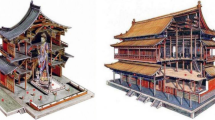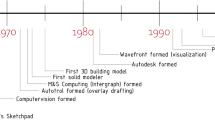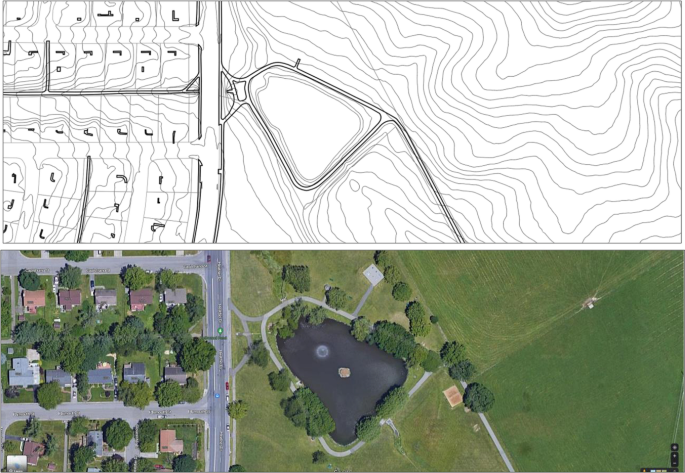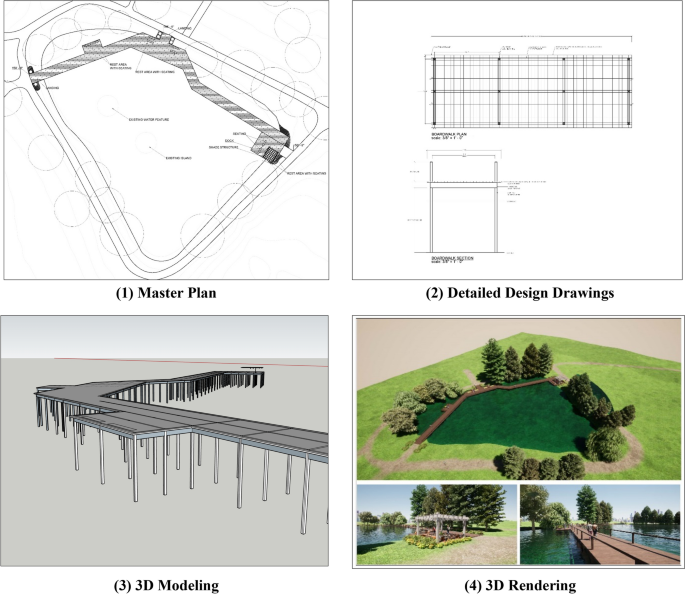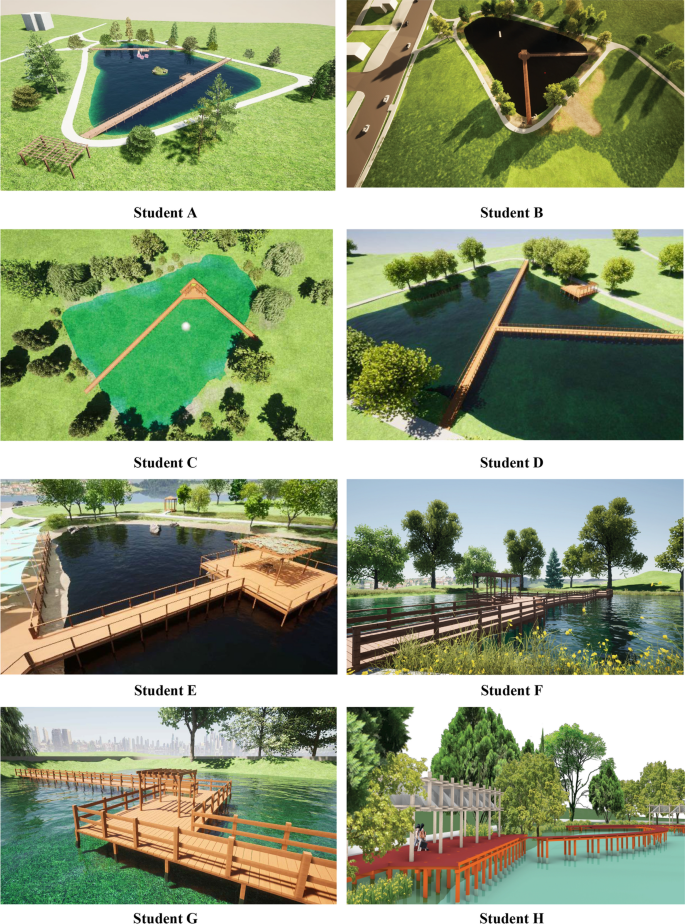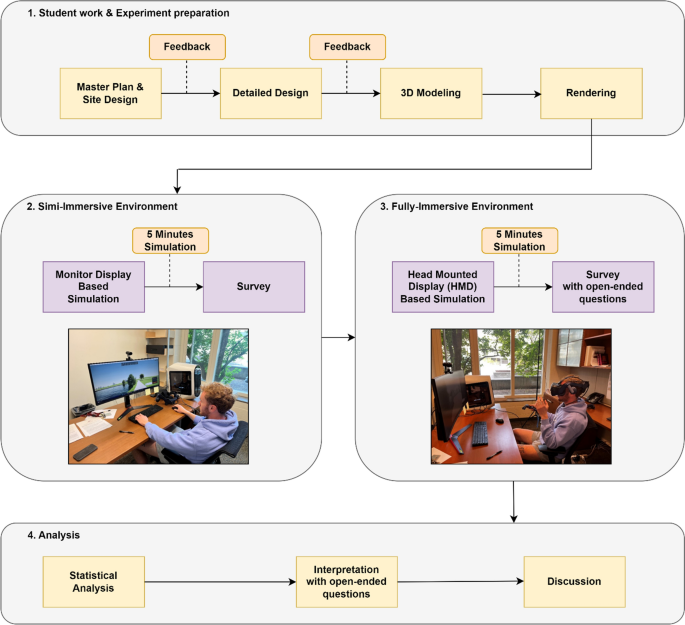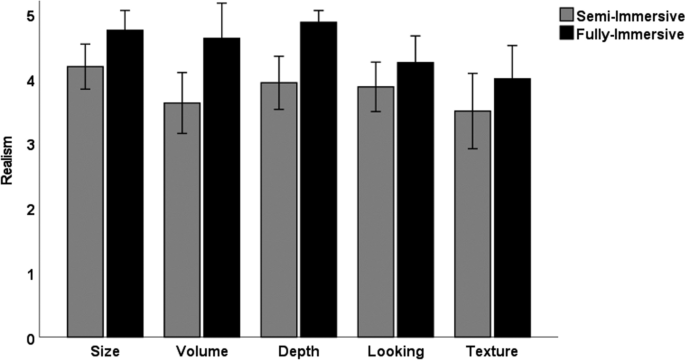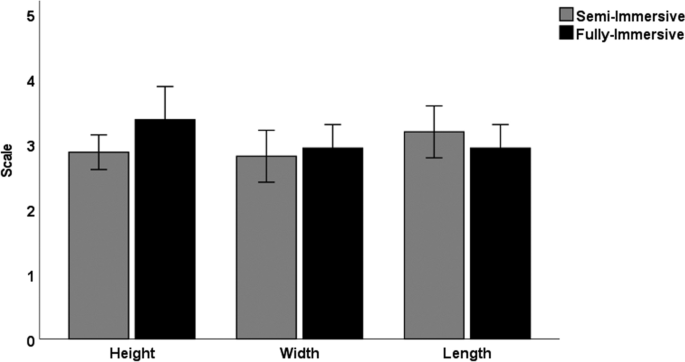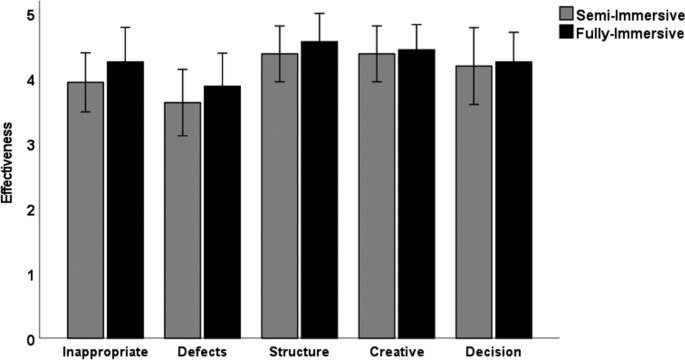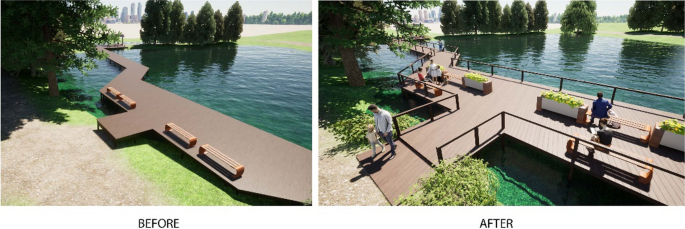Abstract
There is much interest in employing computer technology in design professions and education. However, few attempts have been made to apply immersive visualization technology to learn design details in landscape architecture. This study aims to illuminate how virtual reality (VR) technology helps students with design details in landscape architecture. Students were given a course project to create 3D models such as boardwalk structures located in residential pond areas. Based on their 3D models, we asked 16 research participants to answer survey questionnaires about the perception of realism, scale, and effectiveness of using computer technology in semi-immersive environments (e.g., monitor display-based) as opposed to fully immersive environments (e.g., VR head-mounted display-based). The results of our study showed that students had a higher realism in fully immersive environments compared to semi-immersive environments. In terms of perception of scale, participants perceived the height of the simulated model to be higher than they had anticipated in fully immersive environments. While there were no statistically significant findings regarding the effectiveness of design evaluation in the two modalities, students mentioned that VR technology can effectively assist in creating design details, as it provides them with a better understanding of the spatial characteristics of models.
Similar content being viewed by others
Explore related subjects
Discover the latest articles, news and stories from top researchers in related subjects.Avoid common mistakes on your manuscript.
1 Introduction
As computer graphics and visualization rapidly develop and gain widespread popularity, there is a significant surge in the adoption of computer software for design education [1, 2]. Learning two-dimensional (2D) and three-dimensional (3D) software, including AutoCAD, Rhino, and Sketchup, improves students’ ability to visualize and articulate their ideas with greater freedom [3]. Using computer software increases accuracy, neatness, and ease of modification for design works, thereby achieving time and cost efficiency for students [4].
Despite the benefits of computer graphics and visualization, students encounter several limitations when using 2D and 3D technology in the design field. One significant challenge lies in the conventional 2D monitor (e.g., LCD, LED display), which delivers a lower realism of visual representation in design models [5, 6]. This limitation is problematic because students struggle to bridge the gap between imagination (their design works) and real-world design problems [7]. The computer drawings are unable to fully depict how their class design outputs are generated and produced on-site due to the distance of the model displayed on a monitor screen [8]. Thus, students do not understand the real scale and texture of their model when it is being built. As a result, this challenge discourages students from properly evaluating their design project and identifying potential flaws in their model.
The emerging immersive 3D visualization technologies, such as virtual reality (VR), are unlocking new opportunities for design exploration and presentation [9]. VR employs computer graphics systems in conjunction with a diverse array of interface and display devices to promote the sense of immersion in an interactive 3D computer-generated environment, wherein the virtual exhibits a spatial presence [10]. Sensory information is transmitted through a head-mounted display (HMD) equipped with a head movement tracking system, which provides seamless real-time visual representation, thereby allowing for a sense of full immersion [11, 12] and a feel of presence [13, 14]. VR serves as a tool for people to visualize, manipulate, and interact with intricate computer systems and data information [15, 16]. It has significant potential for solving today's real-world problems [17].
The architectural professions use VR for various purposes, including communicating design specifications, finding appropriate design solutions, providing interactive design experiments, and improving understanding and learning of design concepts [18]. VR technology introduces the crucial aspects of immersion and interactivity to 3D computer-generated models, allowing unprecedented “exploration” that surpasses the limitations of the conventional forms of representation in professional domains [19]. The adoption of VR applications in various design fields has yielded significant improvements in teaching and training performance, enabling engineers and designers to apply theoretical knowledge to the practice of industry through real-time experiences [20,21,22].
In particular, VR becomes an integral design educational tool as it facilitates the transition from a teacher-centered methodology to a student-centered approach [23]. This is partially attributed to VR's capability to enable students to reflect on the functional and formal characteristics of architectural spaces [24]. Building upon this foundation, there is a small but growing body of studies investigating how VR plays a significant role in improving the spatial understanding of 3D spaces for untrained designers by evaluating students’ spatial perception [25]. Paes et al. [26] found that students generally have a better spatial perception of their design model in fully immersive environments. To verify this, spatial perception questionnaires were utilized to assess vertical distances, area of space, spatial positioning of elements, and shape using a 5-point Likert scale. Similarly, Hou et al. [27] also mentioned that the use of VR in design education can enhance students’ perception of scale, as it has an equivalent effect to training in real space. The accuracy of dimension judgment (e.g., distances from a virtual point to objects) was assessed to identify perception of scale. In Ceylan [28]’s study, students gained more benefits in perceiving the physical characteristics of a model (e.g., dimensions of the model) when using VR. The prediction of dimension, including length, width, height, and total used area, was evaluated using the percentile proximity of the actual size of the model. Additionally, open-ended questions were examined for their impressions of the models and their preference for using VR in design models.
Despite the considerable body of studies on immersive visualization technology over the last decades, few studies have examined how this emerging technology can improve the design process and facilitate the comprehension of design details in landscape architecture. Furthermore, to the best of our knowledge, no studies have explored the effectiveness of VR in learning design details based on students’ project outputs. Immersive VR environments equipped with high-resolution HMDs enable users to experience high realism, thereby providing a real-scale perception of spaces and high precision in material representation [8, 29]. VR allows users to experience spaces from their own perspective by generating 3D spatial information on a full scale and presenting the illusion of depth and immersion [30, 31]. Thus, enhanced awareness of the 3D elements and factors in design details through VR promotes spatial cognition, aiding users in making more informed design decisions [32,33,34] and identifying potential design defects [35].
This study proposes to integrate VR technology into landscape architecture design detail courses to enhance students' learning outcomes effectively. In the class final project, students are required to construct different types of wood structures in residential community pond areas and simulate their design using two different methods: (1) conventional way: 3D simulation in the semi-immersive environment (monitor display-based simulation), and (2) the proposed way: the fully immersive environment (VR HMD-based simulation). Our research team examines students’ work to determine how VR can enhance their understanding of learning landscape design detail by evaluating spatial realism, spatial scale, and the effectiveness of using emerging technology. To achieve our goal, this study examines three main research questions: (1) To what extent does students’ perception of realism in the design model differ between semi-immersive and fully immersive environments? (2) To what extent does students’ perception of scale in the design model differ between two different modalities? (3) How effective do students feel when implementing detailed designs in two different modalities?
2 Methods
2.1 Experiment design
2.1.1 Overview of the research procedure
The present study utilized students’ final project of LAR 3164: Design in Detail, a prerequisite course for construction documentation studio in the landscape architecture program at Virginia Tech in the United States. This course targets third-year undergraduates and encompasses theoretical and practical aspects of building construction education and its development for landscape architects. LAR 3164 aimed to teach students about landscape construction details and their impact on design, enhance their skills in traditional and digital construction methods, and explore the forces, properties, limitations, and mitigation strategies related to materials selection. We selected this course for our research experimental settings because students learn a wide range of practical detail designs for landscape construction.
This study had only 16 participants. A small sample size is common due to the nature of design education, wherein educators individually trained and guided each student through their semester-long project. However, the sample size is sufficient for the purpose of this project and in accordance with relevant literature [23, 36, 37]. Based on the outputs of each student’s final project work, we asked several questions to examine our research goals and objectives. In our survey consent form, we included the statement, “Research participation may not affect grades, recommendation letters, or other opportunities or decisions made by teacher-investigators” to ensure a non-oppressive environment for students. This study was approved by the Virginia Tech Institutional Review Board (IRB).
2.1.2 Student’s work procedures (Assignment instructions)
The aim of the final project in LAR 3164 is to enhance students’ understanding and skills in designing wooden structure models for the pond area in the apartment community in Blacksburg, Virginia. The site is frequented by students, faculty members, and seniors of the community for outdoor recreational activities, including walking and jogging. The area of the pond is approximately 70,143 square feet. Figure 1 shows a satellite and a digital base map of the pond area as given to the students. The students were tasked with designing and strategically placing three wood structural elements: a wooden boardwalk, a resting deck, and a wood overhead structure (e.g., pergola), taking into consideration the natural surroundings and the pond’s proximity.
The project consisted of three main parts: site planning and design (master plan), the execution of detailed design drawings, 3D modeling and rendering, and the research experiment phase (see Fig. 2). In Phase 1, students analyzed the site, developed designs for the structural elements, and decided on the materials and structural configurations. In Phase 2, students translated their master plan design into 2D detail design drawings using AutoCAD.Footnote 1 The instructors provided feedback on their design structures and specifications. Phase 3 focused on 3D modeling using SketchUpFootnote 2 and RhinoFootnote 3 based on their 2D detailed drawings. Finally, the outcome of the 3D model design was rendered via Twinmotion EDU 2022.2.3.Footnote 4 The students’ work served as a preparation for the research experiment.
2.1.3 Survey methodology
For the research experiment, students imported their final 3D wood structure models into Twinmotion software to be used for the simulation experiment (see Fig. 3). The main idea of this experiment is to test the perception of realism, scale, and effectiveness on the 3D boardwalk simulation by comparing semi-immersive and fully immersive environments. We asked about the extent of realism of computer simulation in size, volume, depth, view, and texture using a 5-point Likert scale (1 = Nothing; 5 = Much) derived from Gómez-Tone, Bustamante Escapa [8] survey questionnaires. The survey questionnaires inquire about “how much realism gives space the perception of its real size, volume, depth, view, and texture respectively?”. A higher value for each metric indicates that participants perceive a greater sense of realism when observing their visualized models, while a lower value implies respondents perceive less realism in each metric. These questionnaires identify whether two different modalities create differences in the perception of realism among student participants.
In terms of scale, we asked questions about the spatial scale regarding their simulated design models. Since students individually produce their own models and have different dimensions of their works, we cannot ask for the absolute size of design models to assess the participant’s sense of scale (e.g., how many feet wide do you think your simulated model is), as in previous studies. Furthermore, they were already well-informed about the dimensions of detailed drawings while working on the 3D modeling process. Thus, we measured the participants’ relative size of an object as compared to their reference by asking the extent of the degree to which students expected the scale of their boardwalk models. “On a scale of 1 to 5, where 1 indicates that the size of the simulated model is much smaller than your expectations and 5 indicates that the size of the simulated model (boardwalk) is much larger than your expectations in height, width, and length” using a 5-point Likert scale (1 = Very small; 5 = Very large). A higher value for each metric demonstrates that simulated models in each modality are larger than the participant’s expectations. A lower value implies that simulated models are smaller than their expectations.
The last part of the survey asked about the extent of effectiveness of computer simulation finding defects of scale, and structure in two different modalities using a 5-point Likert scale (1 = Strongly disagree; 5 = Strongly agree). The survey questionnaires include “Do you think this simulation helps you to find any inappropriate scale, material (texture) defects, overall errors, and defects of structure in your design model?”. A higher value of each metric depicts that each modality is effective in identifying errors in their models, while a lower value indicates that each modality is not effective. We also asked how computer simulation can help design solutions and decision-making processes using the same Likert scale. Only after a fully immersive environment experience did we ask open-ended questions about how VR can help in the process of design details: “How will VR assist you in making better decisions regarding the outcome of your design?” and “Provide two advantages of using a fully immersive environment (VR HMD-based) when simulating your model as compared to a semi-immersive environment (monitor display-based).”
2.1.4 Experimental procedure
The experiment was conducted in two consecutive parts: (1) a semi-immersive environment experience followed by a survey designed by the researchers and (2) testing the 3D model in a fully immersive VR environment experience followed by a survey including open-ended questions, as shown in Fig. 4. Each student was allotted 30 min to participate in the entire research procedure. The semi-immersive environment experience entailed testing the project within a 2D monitor display-based semi-immersive environment setup. The students navigated their 3D models using mouse and keyboard controls via a wide 34-inch LG monitor display (2560 × 1080 resolution) for approximately 5 min. The students then completed a survey assessing their perception of realism, scale, and effectiveness of semi-immersive visualization technology.
In the second part, the same 3D models were tested in a fully immersive VR environment using the HTC VIVE PRO VR system and HMD for 5 min. Twinmotion provides “VR mode” to enable users to navigate 3D models in fully immersive environments. The participants completed a survey specific to this aspect of the experiment. Additionally, two open-ended questions were included to explore how VR could enhance decision-making and the advantages of using VR for this project.
2.1.5 Participants’ demographics
A total of 16 students participated in this research at the end of the semester. Out of the 16 students, 9 were female, and 7 were male. The age groups ranged as follows: under 20 (6 students), 20–25 (8 students), 25–30 (1 student), and 30–35 (1 student). The vast majority of participants were white (10 students), followed by Asian (4 students), Latino (1 student), and one student did not respond. Among them, 12 students were undergraduates, and 4 were at the graduate level. Additionally, 10 out of the 16 students reported having VR experience before this experiment.
2.2 Data analysis
2.2.1 Statistical analysis
Our study design performed repeated measures of each participant’s response in semi-immersive and fully immersive environments. Since our data was not normally distributed, the non-parametric test is more suitable for examining our research questions. Therefore, the Wilcoxon signed-rank test was applied to examine the differences in participants’ perceptions between semi-immersive and fully immersive environments. The rank-order test method is more robust when the sample sizes are too small to meet the underlying assumption of continuous data (e.g., probability distributions) [38]. The minimum sample size threshold for non-parametric asymptotic tests is 16 [39, 40]. Statistical analysis was performed using IBM SPSS Statistics 28. Under each three main research questions, we have sub-questions to test whether it has a statistically significant difference between two different environments. The Wilcoxon signed-rank test measures each sample twice to perform pairs of observations. The effect size (r) was computed as the absolute Z statistic divided by square root of the sample size. Cohen [41] noted that effect sizes are often classified as small (≈ 0.2), medium (≈ 0.5), or large (greater than or equal to 0.8).
3 Results
3.1 Realism
The results of the Wilcoxon signed-rank test revealed a statistically significant difference between the scores of realism in semi-immersive and fully immersive environments. The fully immersive environment had a higher realism score in size than the semi-immersive environment, Z = − 2.714, p = 0.007, with a medium effect size (r = 0.679). In terms of volume, the fully immersive environment had a higher realism score than the semi-immersive environment, Z = − 3.358, p = < 0.001, with a large effect size (r = 0.840). In addition, the fully immersive environment had a higher realism score in depth than semi-immersive environments, Z = − 3.217, p = 0.001, with a large effect size (r = 0.804) (see Fig. 5 and Table 1).
3.2 Scale
The results of the Wilcoxon signed-rank test revealed a statistically significant difference between the scores in semi-immersive and fully immersive environments. The score for height was significantly greater in the fully immersive environment compared to the semi-immersive environment, Z = − 2.070, p = 0.038, with a medium effect size (r = 0.518). The mean height value in the fully immersive environment was 3.38, indicating that participants perceived the height of the simulated model to be higher than they had anticipated. However, the two systems had no statistically significant difference in the perception of width and length. The score for width in the fully immersive environment was less than in the semi-immersive environment. The score for length in the fully immersive environment was greater than in the semi-immersive environment (see Fig. 6 and Table 2).
3.3 Effectiveness
The Wilcoxon signed-rank test results showed no statistically significant difference in identifying inappropriate scale, material defects, and structural defects between the semi-immersive and fully immersive environments. In addition, no statistically significant differences were found in assistances of creativity of details and design decision-making in the semi-immersive environment compared to the fully immersive environment. Although all variables were not statistically significant, most participants still found fully immersive environments effective in identifying design flaws and aiding in decision-making. (see Fig. 7 and Table 3).
4 Discussion
This research attempts to uncover how immersive visualization technology can be effective in structural detail design in landscape architecture. To the best of our knowledge, no studies have examined how immersive visualization technology can promote landscape design details based on students’ design works. Expectedly, the results of the study showed that fully immersive environments could give students higher realism in size, volume, and depth while navigating their 3D models compared to semi-immersive environments. This is in line with previous findings that VR can give users a higher level of realistic experience [42, 43]. Participants especially feel a considerable gap in realism in the volume and depth of their model in two different environments. The fully immersive environment is more likely to offer participants a higher realism by incorporating texture, shading, shadow, and lighting [44]. This outcome illustrates that VR can be useful because it promotes the comprehension of specific design features (e.g., layout, scale, and dimension) during the design review process [45].
Regarding the perception of scale, the mean values of height, width, and length were close to 3, indicating that the dimensions of simulated 3D models exhibited the intended scale in semi-immersive and fully immersive environments. When comparing the two systems, the Wilcoxon signed-rank test results revealed no statistically significant difference in the perceived width and length of their wood structure models. This is because students were familiar with the length and width of their model. When they conducted the detailed design drawing process, they referred to tables from textbooks that explained the maximum spans and distances of each beam, span, and post. Furthermore, the width and length of the wood structure model are also easily assessed with 2D drawings without 3D perspective drawings.
However, students perceived that the height of the simulated model was much higher than their expectations in fully immersive environments. One explanation is that the model’s height is not easily assessed in the semi-immersive environment because it cannot properly project topography with surrounding environments at eye level. In fully immersive environments, the height of the wood structure felt higher as VR gives more realism in the depth of the pond area and provides the real or natural scale [8]. In open-ended questions, students mentioned that scale was more recognized in VR simulation as they could observe objects in their eye level perspectives (i.e., their vision height in the real world) (Refer to Table 4 for comments provided by student H). Thus, their perception of height via semi-immersive environments might be inaccurate, whereas fully immersive environments might be closer enough to the real scale with a high accuracy. Taking this into consideration, students tended to design a lower height of wood structure than intended when building 3D models.
Surprisingly, the findings of this study revealed no significant difference in participants’ perception of the effectiveness of evaluating their design work in fully immersive and semi-immersive environments. This is partly because students went through their design while building a 3D model in SketchUp. During the design stage, they already acknowledged the possible defects in their model, including size, texture, and structure. Though the results showed no statistical difference, students were more likely to feel effective when they explored their design model in a fully immersive environment.
The answers derived from open-ended survey questions support the effectiveness of using VR in detail design for students. One main benefit highlighted by participants was the ability of VR to enhance their understanding of real scale and spatial relationships. By immersing themselves in a virtual environment, they could have a cognitive experience from a first-person perspective [34], gaining a better sense of the size and proportions of objects and spaces related to their structural design. Immersive visualization technology allowed them to make more informed decisions when designing detailed elements of their projects.
Second, the participants emphasized the value of VR in assessing material properties and texture through close examination as it gives a more realistic sensation [46]. This enabled them to make more accurate judgments about the suitability of materials and ensured their design aligned with their intended aesthetics and functional goals. Third, the participants highlighted the role of VR in identifying design issues and facilitating the iterative design process. They could easily spot misalignments, connections, and other potential flaws. These early detections of issues empowered them to make necessary adjustments before final submission. The study participants acknowledged the convenience of VR in bridging the gap between the 2D drawing works and the simulation of the 3D model [47]. This transition facilitated better decision-making about scale, materials, and overall site context.
After our experiment, we also asked students to revise their 3D drawings and renderings based on defects found in their VR experiences as an activity for students to reflect on their constructed models (see Fig. 8). One student observed several issues found in the original wood structure models while experiencing VR simulation, such as the structure’s scale, seating arrangements, and the leveling of the boardwalk with existing topography. Several drawing revisions were made to easily transition between the boardwalk and the existing path, enlarging the pergola, rearranging the seating, and utilizing plantings to break up the space. Throughout the VR simulation, students acknowledged that VR can effectively assist in identifying structural defects in their model and implementing modifications of drawings. This finding supplements a broader body of work that explores the efficacy of using VR in landscape design detail.
4.1 Limitations and implications
Though this study highlights several implications for design educators, there are some limitations in our study. First, due to the class size and limited resources, only 16 students participated in our study. The small sample size can limit statistical power and lower the external validity of this study. Although we addressed this issue using a non-parametric test, we strongly recommend that future studies consider using a larger sample size to increase statistical power.
Second, although we had open-ended questions in our survey, we mainly relied on questionnaires utilizing the 5-point Likert scale to inquire about students’ perceptions of their 3D models. To identify more details, the semi-structured interview is highly encouraged for each participant.
Third, there is a technological limitation in the current VR HMD. Even though the VIVE Pro 2 has a high resolution (2448 × 2448 pixels per eye), some participants feel cybersickness (e.g., dizziness, nausea, and headaches) caused by sensory mismatch (i.e., a sense of self-movement in VR environments while physically stationary in the real word environments) [48,49,50]. This technological limitation may lead to variations in participants’ responses to the survey [48]. To address this fact, future studies need to employ a simulation sickness questionnaire (SSQ) to consider potential confounding effects [51, 52].
Fourth, we were unable to evaluate how participants accurately provided the precise measurement of their respective wood structure models. As each participant designed their own 3D model, each wood structure model exhibited considerable variation in width, length, and height. Thus, we had no choice but to assess the perceived scale from participants rather than the actual measurement in this study. Future research might need to assign students wood structure drawings with identical dimensions like previous studies [26,27,28].
Lastly, this study did not consider the order of research procedures in our experiment. Participants experienced the 3D simulation in semi-immersive environments first, and afterward, they experienced the same 3D simulation in fully-immersive environments. Though several experimental studies found there was no main effects in the sequence of experiments [53,54,55], this sequential judgment might be susceptible to distortion, as two forms of contexture effects can influence each other [56]. To mitigate this effect, future studies should take into account this carryover effect by incorporating two different orders of research experiments.
The advantages of immersive VR for detail designs surpass those of the semi-immersive computer monitor experience. The ability to fully immerse oneself, understand scales more accurately, physically interact with space, and navigate easily contributes to a more realistic and comprehensive simulation experience. As VR technology continues to evolve, its integration into landscape construction design workflows holds great promise for improving decision-making, enhancing user experiences, and pushing the boundaries of design innovation. This study bridges industrial needs with educational demonstrations and provides some necessary suggestions for more practical design education.
5 Conclusion
Computer technology plays a significant role in assisting the design works for students. However, conventional 3D graphic software has a limitation in that it cannot produce realism, failing to detect defects in design outcomes. This study aimed to explore how VR technology can assist students with design details in landscape architecture. To achieve this goal, we asked students to design wood structure details such as boardwalks in residential pond areas. Based on their design works, 16 students were asked to answer survey questionnaires about the perception of realism, scale, and effectiveness of computer technology by comparing semi-immersive (e.g., monitor display-based) and fully immersive environments (e.g., VR HMD-based). Our findings showed that participants were more likely to feel a higher level of realism in size, volume, and depth in fully immersive environments than in semi-immersive environments. Furthermore, participants responded with varying perceptions of the scale, particularly with regard to the height of wood structure details, between the two different environments. Though there was no statistical significance, participants answered that a fully immersive environment could facilitate the creation of design details in landscape architecture. VR can help participants better understand the size and proportions inherent in their design objects. These findings show that emerging technology empowers students to elevate their creative design output by achieving greater precision and fidelity in their work.
Data availability
The data presented in this study are available on request from the corresponding author. The data are not publicly available due to the protection of privacy.
Code availability
Not applicable.
Notes
AutoCad 2023 is being used with an educational account at Virginia Tech.
SketchUp Studio is being purchased as the student version (Link: https://www.sketchup.com/plans-and-pricing#for-higher-education).
Rhino 8 is being used with an educational account at Virginia Tech.
Twinmotion is available in the education edition (Link: https://www.twinmotion.com/en-US/license).
References
Guney D. The importance of computer-aided courses in architectural education. Procedia Soc Behav Sci. 2015;176:757–65.
Soliman S, Taha D, El Sayad Z. Architectural education in the digital age: computer applications: Between academia and practice. Alex Eng J. 2019;58(2):809–18.
Khiati S. CAD and 3D Visualization software in design education: is one package enough. J Eng Appl Sci. 2011;3(2):91–100.
Fakhry M, Kamel I, Abdelaal A. CAD using preference compared to hand drafting in architectural working drawings coursework. Ain Shams Eng J. 2021;12(3):3331–8.
Shiratuddin MF, Thabet W, Bowman D. Evaluating the effectiveness of virtual environment displays for reviewing construction 3D models. CONVR. 2004;2004:87–98.
Lindquist M, Maxim B, Proctor J, Dolins F. The effect of audio fidelity and virtual reality on the perception of virtual greenspace. Landsc Urban Plan. 2020;202: 103884.
Kamath RS, Dongale TD, Kamat RK. Development of virtual reality tool for creative learning in architectural education. Int J Qual Assur Eng Technol Educ IJQAETE. 2012;2(4):16–24.
Gómez-Tone HC, Bustamante Escapa J, Bustamante Escapa P, Martin-Gutierrez J. The drawing and perception of architectural spaces through immersive virtual reality. Sustainability. 2021;13(11):6223.
Camba JD, Soler JL, Contero M, editors. Immersive visualization technologies to facilitate multidisciplinary design education. In: Learning and collaboration technologies novel learning ecosystems: 4th International Conference, LCT 2017, Held as part of HCI international 2017, Vancouver, BC, Canada, July 9–14, 2017, Proceedings, Part I 4. Springer; 2017.
Bryson S. Approaches to the successful design and implementation of VR applications. In: Earnshaw R, Vince J, Jones H, editors. Virtual reality applications. San Diego: Academic Press; 1995. p. 3–15.
Garrett B, Taverner T, Gromala D, Tao G, Cordingley E, Sun C. Virtual reality clinical research: promises and challenges. JMIR Serious Games. 2018;6(4): e10839.
Maples-Keller JL, Bunnell BE, Kim S-J, Rothbaum BO. The use of virtual reality technology in the treatment of anxiety and other psychiatric disorders. Harv Rev Psychiatry. 2017;25(3):103.
Schubert T, Friedmann F, Regenbrecht H. The experience of presence: Factor analytic insights. Presence Teleoperators Vir Environ. 2001;10(3):266–81.
van Brakel V, Barreda-Ángeles M, Hartmann T. Feelings of presence and perceived social support in social virtual reality platforms. Comput Hum Behav. 2023;139: 107523.
Isdale J. What is virtual reality. Virtual Reality Information Resources. 1998;4. http://www.isxcom/jisdale/WhatIsVrhtml.
Kizil M. Virtual reality applications in the Australian minerals industry. In: Application of computers and operations research in the minerals industries, South African. 2003. p. 569–74.
Ferreira A, Mavroidis C. Virtual reality and haptics for nanorobotics. IEEE Robot Autom Mag. 2006;13(3):78–92.
Kamińska D, Sapiński T, Wiak S, Tikk T, Haamer RE, Avots E, et al. Virtual reality and its applications in education: Survey. Information. 2019;10(10):318.
Portman ME, Natapov A, Fisher-Gewirtzman D. To go where no man has gone before: Virtual reality in architecture, landscape architecture and environmental planning. Comput Environ Urban Syst. 2015;54:376–84.
Abulrub A-HG, Attridge AN, Williams MA, editors. Virtual reality in engineering education: The future of creative learning. In: 2011 IEEE global engineering education conference (EDUCON); 2011. IEEEl 2011.
Pantelidis VS. Reasons to use virtual reality in education and training courses and a model to determine when to use virtual reality. Themes Sci Technol Educ. 2010;2(1–2):59–70.
Teklemariam HG, Kakati V, Das AK, editors. Application of VR technology in design education. In: DS 78: proceedings of the 16th international conference on engineering and product design education (E&PDE14), design education and human technology relations, University of Twente, The Netherlands, 04–0509 2014; 2014; 2014.
Bashabsheh AK, Alzoubi HH, Ali MZ. The application of virtual reality technology in architectural pedagogy for building constructions. Alex Eng J. 2019;58(2):713–23.
Valls F, Redondo E, Sánchez A, Fonseca D, Villagrasa S, Navarro I. Simulated environments in architecture education. In: Improving the student motivation. Recent advances in information systems and technologies, vol. 3. 5th ed. Springer; 2017.
Alatta RA, Freewan A. Investigating the effect of employing immersive virtual environment on enhancing spatial perception within design process. ArchNet-IJAR Int J Architect Res. 2017;11(2):219.
Paes D, Arantes E, Irizarry J. Immersive environment for improving the understanding of architectural 3D models: comparing user spatial perception between immersive and traditional virtual reality systems. Autom Constr. 2017;84:292–303.
Hou N, Nishina D, Sugita S, Jiang R, Kindaichi S, Oishi H, et al. Virtual reality space in architectural design education: learning effect of scale feeling. Build Environ. 2024;248: 111060.
Ceylan S, editor. Using virtual reality to improve visual recognition skills of first year architecture students: a comparative study. CSEDU, 2; 2020.
Herman L, Juřík V, Snopková D, Chmelík J, Ugwitz P, Stachoň Z, et al. A comparison of monoscopic and stereoscopic 3D visualizations: Effect on spatial planning in digital twins. Remote Sens. 2021;13(15):2976.
Azarby S, Rice A. Understanding the effects of virtual reality system usage on spatial perception: the potential impacts of immersive virtual reality on spatial design decisions. Sustainability. 2022;14(16):10326.
Kalisperis L, Muramoto K, Balakrishnan B, Nikolic D, Zikic N. Evaluating relative impact of virtual reality system variables on architectural design comprehension and presence. In: Proceedings of eCAADe2006, Volos, Greece; 2006.
George BH, Sleipness OR, Quebbeman A. Using virtual reality as a design input: impacts on collaboration in a university design studio setting. J Dig Landsc Architect. 2017;2:252–9.
Chamberlain BC. Crash course or course crash: Gaming, VR and a pedagogical approach. J Digit Landsc Arch. 2015;354.
Azarby S, Rice A. User performance in virtual reality environments: the capability of immersive virtual reality systems in enhancing user spatial awareness and producing consistent design results. Sustainability. 2022;14(21):14129.
Gómez-Tone HC, Martin-Gutierrez J, Bustamante-Escapa J, Bustamante-Escapa P. Spatial skills and perceptions of space: representing 2D drawings as 3D drawings inside immersive virtual reality. Appl Sci. 2021;11(4):1475.
Messner J, Yerrapathruni S, Baratta A, Whisker V, editors. Using virtual reality to improve construction engineering education. In: 2003 annual conference; 2003.
Azhar S, Kim J, Salman A, editors. Implementing virtual reality and mixed reality technologies in construction education: students’ perceptions and lessons learned. In: ICERI2018 proceedings; 2018: IATED.
Riffenburgh RH. Chapter 16—tests on ranked data. In: Riffenburgh RH, editor. Statistics in Medicine. 2nd ed. Burlington: Academic Press; 2006. p. 281–303.
Siegel S, Castellan NJ. Nonparametric statistics for the behavioral sciences. 2nd ed. New York: McGraw-Hill; 1988.
Snedecor GW, Cochran WG. Statistical methods. 7th ed. Ames: Iowa State University Press; 1980.
Cohen J. Statistical power analysis for the behavioral sciences. Academic press; 2013.
Newman M, Gatersleben B, Wyles KJ, Ratcliffe E. The use of virtual reality in environment experiences and the importance of realism. J Environ Psychol. 2022;79: 101733.
Hvass J, Larsen O, Vendelbo K, Nilsson N, Nordahl R, Serafin S, editors. Visual realism and presence in a virtual reality game. In: 2017 3DTV conference: the true vision-capture, transmission and display of 3D video (3DTV-CON). IEEE; 2017.
Nikolic D. Evaluating relative impact of virtual reality components detail and realism on spatial comprehension and presence. Pennsylvania State University; 2007.
Castronovo F, Nikolic D, Liu Y, Messner J, editors. An evaluation of immersive virtual reality systems for design reviews. In: Proceedings of the 13th international conference on construction applications of virtual reality; 2013: CONVR 2013) London, UK.
Pardo PJ, Suero MI, Pérez ÁL. Correlation between perception of color, shadows, and surface textures and the realism of a scene in virtual reality. JOSA A. 2018;35(4):B130–5.
Koller S, Ebert LC, Martinez RM, Sieberth T. Using virtual reality for forensic examinations of injuries. Forensic Sci Int. 2019;295:30–5.
Caserman P, Garcia-Agundez A, Gámez Zerban A, Göbel S. Cybersickness in current-generation virtual reality head-mounted displays: systematic review and outlook. Virtual Reality. 2021;25(4):1153–70.
Davis S, Nesbitt K, Nalivaiko E, editors. A systematic review of cybersickness. In: Proceedings of the 2014 conference on interactive entertainment; 2014.
Simón-Vicente L, Rodríguez-Cano S, Delgado-Benito V, Ausín-Villaverde V, Cubo Delgado E. Cybersickness. A systematic literature review of adverse effects related to virtual reality. Neurologia. 2022. https://doi.org/10.1016/j.nrl.2022.04.009.
Bouchard S, Berthiaume M, Robillard G, Forget H, Daudelin-Peltier C, Renaud P, et al. Arguing in favor of revising the simulator sickness questionnaire factor structure when assessing side effects induced by immersions in virtual reality. Front Psych. 2021;12: 739742.
Tadeja SK, Lu Y, Rydlewicz M, Rydlewicz W, Bubas T, Kristensson PO. Exploring gestural input for engineering surveys of real-life structures in virtual reality using photogrammetric 3D models. Multimedia Tools Appl. 2021;80:1–20.
Tawil N, Sztuka IM, Pohlmann K, Sudimac S, Kühn S. The living space: psychological well-being and mental health in response to interiors presented in virtual reality. Int J Environ Res Public Health. 2021;18(23):12510.
Rashidian N, Giglio MC, Van Herzeele I, Smeets P, Morise Z, Alseidi A, et al. Effectiveness of an immersive virtual reality environment on curricular training for complex cognitive skills in liver surgery: a multicentric crossover randomized trial. HPB. 2022;24(12):2086–95.
Carrougher GJ, Hoffman HG, Nakamura D, Lezotte D, Soltani M, Leahy L, et al. The effect of virtual reality on pain and range of motion in adults with burn injuries. J Burn Care Res. 2009;30(5):785–91.
Ferris SJ, Kempton RA, Deary IJ, Austin EJ, Shorter MV. Carryover bias in visual assessment. Perception. 2001;30(11):1363–73.
Acknowledgements
The authors thank the Center for Excellence in Teaching and Learning at Virginia Tech for funding this research. This study was supported by the “Scholarship of Teaching and Learning Grants.” We also express our gratitude to the students who participated in this research.
Funding
The authors thank the Center for Excellence in Teaching and Learning at Virginia Tech for funding this research. This study was supported by the “Scholarship of Teaching and Learning Grants.”
Author information
Authors and Affiliations
Contributions
Conceptualization, Jaeyoung Ha, Kawthar Alrayyan, M. M. Lekhon Alam; methodology, Jaeyoung Ha, Kawthar Alrayyan; software, Jaeyoung Ha; formal analysis, Jaeyoung Ha; data curation, Jaeyoung Ha, Kawthar Alrayyan; writing—original draft preparation, Jaeyoung Ha, Kawthar Alrayyan; writing—review & editing, Jaeyoung Ha, M. M. Lekhon Alam.
Corresponding author
Ethics declarations
Consent to participate
Informed consent was obtained from all individual participants included in the study.
Competing interests
The authors have no financial disclosures to declare and no conflicts of interest to report.
Additional information
Publisher’s Note
Springer Nature remains neutral with regard to jurisdictional claims in published maps and institutional affiliations.
Rights and permissions
Open Access This article is licensed under a Creative Commons Attribution 4.0 International License, which permits use, sharing, adaptation, distribution and reproduction in any medium or format, as long as you give appropriate credit to the original author(s) and the source, provide a link to the Creative Commons licence, and indicate if changes were made. The images or other third party material in this article are included in the article's Creative Commons licence, unless indicated otherwise in a credit line to the material. If material is not included in the article's Creative Commons licence and your intended use is not permitted by statutory regulation or exceeds the permitted use, you will need to obtain permission directly from the copyright holder. To view a copy of this licence, visit http://creativecommons.org/licenses/by/4.0/.
About this article
Cite this article
Ha, J., Alrayyan, K. & Alam, M.M.L. Virtual reality technology for learning detailed design in landscape architecture. Discov Educ 3, 39 (2024). https://doi.org/10.1007/s44217-024-00123-9
Received:
Accepted:
Published:
DOI: https://doi.org/10.1007/s44217-024-00123-9


